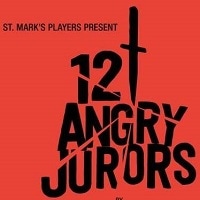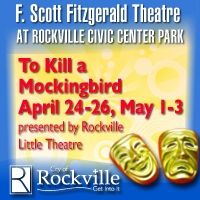There is probably no clearer distillation of classic American courtroom drama than Reginald Rose’s 12 Angry Men. The classic tale of a seemingly cut-and-dry murder case turned upside down by a lone dissenting juror has been captivating audiences since its debut as a television special in 1954. Rose adapted his teleplay into a script, and then a screenplay which became the iconic 1957 film version.
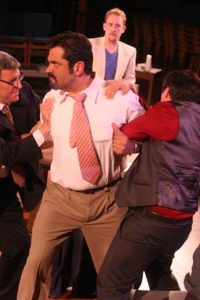
The current revival of the play by St. Mark’s Players, performed in the gorgeous enclave of St. Mark’s Episcopal Church on Capitol Hill, is entitled 12 Angry Jurors to reflect its updated co-ed consistency. Directed by Seth Rose (no relation to playwright Reginald Rose) 12 Angry Jurors is a taut, nuanced, and gripping exploration of how the irrational prejudices of the human mind can threaten the integrity of the American “justice” system.
At the play’s beginning, when the jurors file into the deliberation room, only one, Juror #8 (Samantha Sheahan) votes “not guilty.” She is roundly criticized by her peers, whose motives for voting “guilty” range from apathy and laziness to overt racism (the defendant’s ethnicity is never stated explicitly but he is characterized frequently as “one of them” and other familiar dog whistles). Through a mixture of persuasion, emotional appeal and raw moral clarity, Juror #8 wrestles with her fellow naysayers and eventually finds some kindred spirits.
Samantha Sheahan is rock solid as Juror #8, whose sense of righteousness never falters even as she is challenged in increasingly confrontational ways. Her chief rival is Juror #3 (a compelling Ernie Molina), a Trumpean loud mouth who is the most adamant about delivering a “guilty” verdict although his motivations seem to come from a personal rather than legal place. In contrast, Juror #7 (Kara Turner) is icily no-nonsense about her Machiavellian worldview, even as it becomes increasingly difficult to sustain. Rounding out the #NeverInnocent contingent is Juror #10 (Jesse Marciniak) whose laidback attitude masks an ugly racist attitude that shocks even his fellow “guilty” voters. Marciniak’s late stage monologue detailing the extent of his beliefs is one of the most powerful and revealing moments of the show.
Despite originally being alone in her “not guilty” votes, Juror #8 does attract some early supporters. Chief among them is Juror #9 (John Henderson, in an inventive and emotional performance), an elderly gentleman who by his own admission is an “unimportant” man who seizes the opportunity to try and do the right thing. There is also Juror #5, played with notable authenticity by Elizabeth Hansen, who is the only one of the 12 who, like the defendant, grew up in “the slums”. She offers an important perspective on the world in which the defendant grew up. Finally, Juror #11 (Grant Williams) is an emigre of unknown Slavic origin whose laconic yet astute defense of all that is right and just with the American justice system is a powerful shot of conscience for the other more complacent jurors.
Then there are those in the muddy middle. Juror #4 (Daniel Lavanga) is a ruthlessly reasonable voice of reason who is effective at progressing the story. The Forewoman (Karen Lawrence) is more invested in the proper process of deliberating than she is about the defendant himself. Juror #2 (Kat Shepherd) is a meek older woman whose vote swings back and forth more than a few times during the course of the show. Her ability to be easily manipulated reveals serious flaws in the jury trial process.
Juror #12 (Sakari Ishetiar) is a visually compelling presence on stage whose physicality naturally draws attention. Juror #6 (Frank Mobilio) is a stable presence in the show who glowers from his spot at the table.
Although the space inside St. Mark’s church is cavernous, Director Seth Rose wisely chooses to constrict his playing space into a tight square circumscribed by the audience, which is seated on all four sides. The grandly severe jury table is placed at a slashing angle across the space, maximizing visibility for all audience members. Additionally, Rose is conscious of the danger of too much stasis in the staging. One of the traps in this play is to keep the actors seated, but Rose avoids this for the most part by folding in numerous sequences of physical movement.
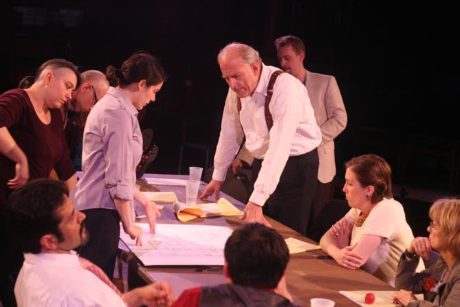
The lighting design, by Jerry Dale, keeps the space warmly illuminated and costumes by Cecilia Albert help to give visual texture to the characters. The sound design, by Niusha Nawab, rings out through the space like the ponderous god of Justice.
Though fifty years old, the message of 12 Angry Jurors could scarcely be more relevant in the age of Trayvon Martin and Eric Garner. The American justice system has never been under more scrutiny, and this play provides some timeless reasons – apathy, ignorance, prejudice – why this is rightly so. The St. Mark’s players do Rose’s script great justice (no pun intended), and the strong performances establish a suspenseful and though provoking nail biter.
Running Time: 90 minutes, with no intermission.
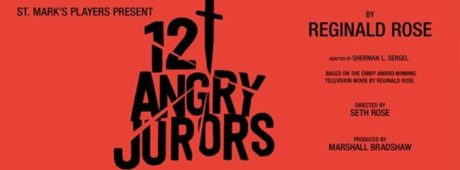
12 Angry Jurors plays through May 21, 2016 at St. Mark’s Players performing at St. Marks Episcopal Church – 301 A Street SE, in Washington, DC. For tickets, call the box office at (202) 546-9670 and leave a message, or purchase them online.
RATING: ![]()
